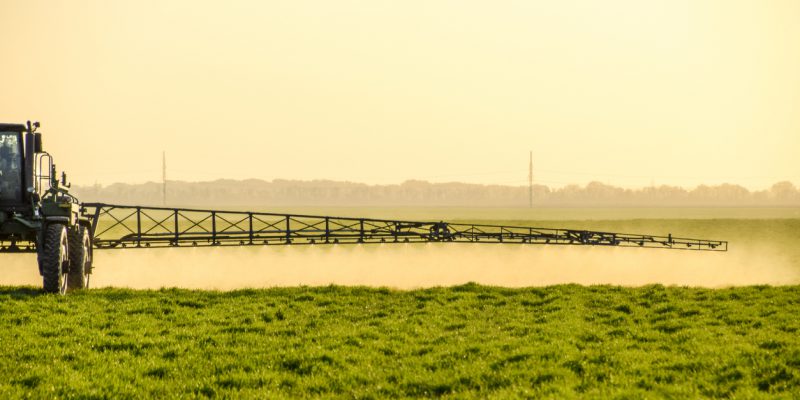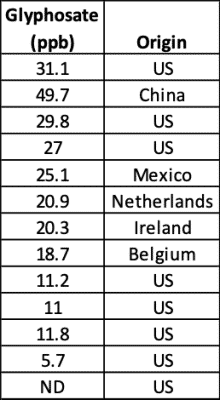From time to time, the brewing industry has faced situations where concerns have surfaced about the health impact of a particular compound that may be present in beer and other foods and beverages. One such situation, for instance, took place in 1978 regarding the level of the known carcinogen, NDMA (nitrosodimethylamine) in malt and beer. A vigorous international response from the brewing technical community took place and two years later methods of analysis and means to control and reduce NDMA levels were implemented.
More recently, a concern has come up about the presence of glyphosate (which is the main chemical in the herbicide RoundupTM) in foods and beverages, including beer. In this brief article we look into the main sources of glyphosate in beer, and the levels found in beer in a recent survey. Although it will continue to be important to take measures to ensure that glyphosate levels in the final product remain low, the literature to date indicates that the levels found in beer, thus far, do not provide evidence that there is a risk for consumers.
Sources of glyphosate in beer.
The main sources of glyphosate in beer are water, malt and hops. And, when used, adjuncts such as corn, rice, oats, honey, etc. can also be contributing sources.
1. Water
Glyphosate is used in over 150 food and non-food crops as well as non-crop areas such as roadsides. Through these and other uses, water sources become contaminated with this chemical. Water surveys in the US have reported levels in a range of 1 to 39 micrograms per liter (ppb), which is well below the U.S. Environmental Protection Agency Maximum Contaminant Level (MCL) of 700 ppb, or Health Canada’s Maximum Acceptable Concentration of 280 ppb. A number of municipal water quality reports in the US and Canada indicate non-detectable levels. A wider global World Health Organization survey found a much wider range 35 to 1237 ppb in water streams (i.e. before water treatment). Glyphosate levels can be lowered through treatment, such as by sedimentation, oxidation, and by the use of activated carbon (which is commonly used at breweries to remove chlorine from the brewing water).
2. Malt
In 2016 the American Malting Barley Association, Inc. (AMBA) issued a statement strongly opposing the use of desiccants or herbicides such as glyphosate for post-heading treatment of malting barley, wheat, or other grains (its use is approved for soil treatment before the seed is planted). The AMBA statement expressed concerns over the effects of glyphosate residues on the malting process, i.e. its impact on barley germination.
Likewise, Canada’s Brewing and Malting Barley Research Institute (BMBRI) issued a statement in 2017 indicating that barley offered for selection for malting must not have been treated with glyphosate. A similar position has been issued in Australia for malting barley (although its use in feed barley is permitted).
The Brewers Association in the US has recommended brewers to require maltsters and suppliers to test malts and verify that these meet expectations (for barley and wheat malts and for other grains used).
The German Brewers Association has a monitoring system for brewing malt and it has shown values to always be well below the maximum limits, and glyphosate use is not permitted in barley production.
Even with these practices, there is the potential of quantifiable levels of glyphosate in malt for various reasons, e.g. spray drift when glyphosate is used for permitted applications on adjacent agricultural lands.
The European maximum residue legal limit for glyphosate is 20 ppm in barley and 10 ppm in wheat. Actual reported levels have been about 100 times lower. And, of those levels, it has also been reported that only about two percent of the glyphosate originally found in raw barley will end up in beer. Part of the reason for this is that during malting a large proportion of chemical residues are washed from the grain by the steep water and destroyed during kilning.
3. Hops
Weeds control in hop yards is important as these can interfere with production by impacting growth and yield (e.g. by competing for nutrients and water), interfere with field operations (e.g. spraying, training, and harvesting), and promote the survival of pests when the hop plants are not actively growing.
Glyphosate is one of about a dozen registered herbicides for use in hops production. Glyphosate is nonselective and controls most emerged weeds. It is to be applied before hop emergence (i.e. not to be used once hop plants have emerged) since it will kill or seriously injure hop plants if allowed to contact hop foliage. Early spring applications are considered safer than fall applications.
In 2013, a joint project was conducted by the University of California Davis and Washington State University on pesticide residues in hops. Of the pesticides applied to the conventionally treated hops, residues were detected for six (the listing did not include glyphosate). All pesticide residues detected were substantially below EPA tolerances. And as could be expected, wet hopping (especially if used post-kettle boil) resulted in higher residual levels (still far below levels of health or regulatory concern).
The relative contribution of glyphosate to beer from hops is low for the simple fact that the amount of hops added per brew is only about 1 to 5% of the weight of malt. Having low levels of glyphosate in hops is still important given its high solubility in water. Maximum levels of 0.1 ppm of glyphosate in hops have been suggested.
4. Other ingredients
When adjuncts are used, such as honey, corn syrup, rice, etc. these too need to be considered as they represent potential sources of glyphosate for the final beer. In one survey, for instance, levels in honey were found to vary from about 10 to 140 ppb. In that survey, samples of corn syrup were found not to have quantifiable levels. Levels in various ingredients such as oats, corn and rice have also varied significantly from 0.1 to over 500 ppb. As in the case of hops, the impact of these levels in the final product will largely depend on the amounts used per brew.
Levels of glyphosate found in Beer
In 2019 the U.S. PIRG Education Fund published a report on glyphosate levels in beer and wine. They tested five wines, two ciders and 13 beer samples. The beer samples came from the US, China, Mexico, Netherlands, Ireland and Belgium, and the table below summarizes the results:
One sample had a non-detectable level, eleven had a level of 30 ppb or lower, and only one sample had a level close to 50 ppb. They acknowledged that “these levels of glyphosate are below EPA risk tolerances for beverages” while noting the possibility of health concerns.
In a 2016 study reported by Abraxis Inc., 112 imported and US beers were analyzed. Six of those samples showed non-quantifiable levels. Only four had a level greater than 30 ppb, with one sample of wheat beer at close to 200 ppb.
Are current levels of glyphosate in beer a health hazard?
The link between glyphosate and cancer potential exists, as it does for many other chemicals. The central question is whether, at the levels currently found in beer, the presence of glyphosate are considered harmful. The U.S. PIRG Education Fund’s position on glyphosate is clear: “Due to glyphosate’s many health risks and its ubiquitous nature in our food, water, and alcohol, the use of glyphosate in the U.S. should be banned unless and until it can be proven safe.”
However, the German Federal Institute for Risk Assessment (BfR) considers the traces that have been found in food products thus far as harmless to human health since the highest level they had seen in their surveys (30 ppb) would mean that in order to ingest quantities of glyphosate that would pose a health risk, an adult would have to drink roughly 1000 litres (i.e. about 2,800 servings of 12 oz) of beer during one day.
Therefore, although certainly important to continue to monitor and reduce where possible, the current glyphosate concentration in beer is not at levels that are considered harmful to consumers at this time.
Outlook
We would anticipate the topic of glyphosate in beer to continue to be of interest to brewers. Further work in measurement methods, tracking of levels in key ingredients and in the final product will be important. Options to further control and reduce these levels, and additional studies or commentary on the relevance of the levels found to carcinogenicity are anticipated.
Dr. Hugo Patiño is the Director of Technical Services at First Key Consulting. Hugo has worked in the beer industry for over 30 years, with leadership roles in the areas of Research & Development, Quality Management, and Technical Services encompassing from barley breeding to brewing and packaging.




